Key points
- place valueThe value of a digit that relates to its position or place in a number. Eg, in 1482 the digits represent 1 thousand, 4 hundreds, 8 tens and 2 units. can be used to multiply or divide whole numbers by 10, 100 or 1,000
- When multiplying, each digit moves to the left.
- When dividing, each digit moves to the right.
Multiplying by 10, 100 and 1,000
place valueThe value of a digit that relates to its position or place in a number. Eg, in 1482 the digits represent 1 thousand, 4 hundreds, 8 tens and 2 units. can be helpful when multiplying by 10, 100 and 1,000. When multiplying by a power of 10 (eg 10, 100, 1,000) placeholdersZero is used as a placeholder if the number does not include a particular power of 10. For example, in 203, there are no tens, so a zero is used as a placeholder in the tens place. are needed to make sure that the number is written correctly.
Multiplying by 10
- To multiply by 10, each digit moves one place to the left. Eg, units become tens.
Multiplying by 100
- To multiply by 100, each digit moves two places to the left. Eg, units become hundreds.
Multiplying by 1,000
- To multiply by 1,000, each digit moves three places to the left. Eg, units become thousands.
Note: units are often referred to as ones. For example, 34 has 3 tens and 4 units, or we could say 34 has 3 tens and 4 ones.
Example: multiplying by 10, 100 and 1,000
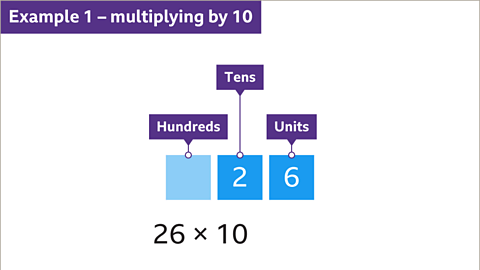
Image caption, Write 26 out with place value labels. To multiply 26 by 10, move each digit one place to the left.
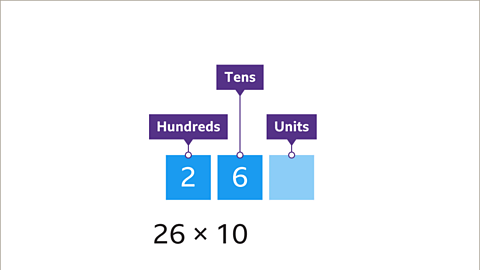
Image caption, Each digit has moved one place to the left. This creates a gap in the units place.
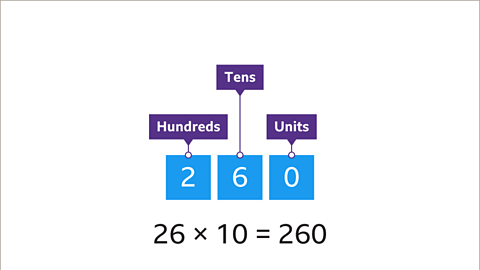
Image caption, There aren’t any units, so insert a 0 as a placeholder in the units place. 26 x 10 = 260
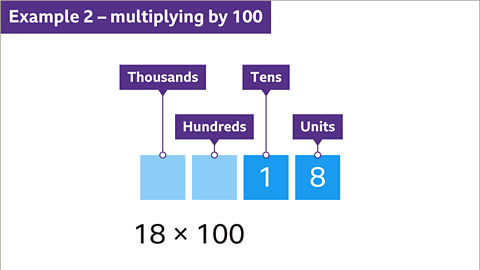
Image caption, Write 18 out with place value labels. To multiply 18 by 100, move each digit two places to the left.

Image caption, Each digit has moved two places to the left. This creates a gap in both the tens and the units place.
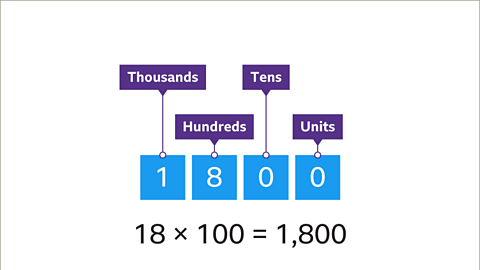
Image caption, There aren’t any tens or units, so insert a 0 as a placeholder in both places. 18 x 100 = 1800
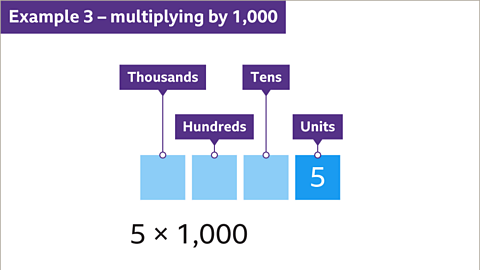
Image caption, Write 5 out with a units place value label. To multiply 5 by 1000, move each digit three places to the left.
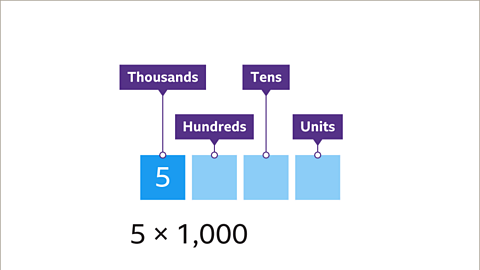
Image caption, Each digit has moved three places to the left. This creates a gap in the hundreds, tens and the units place.
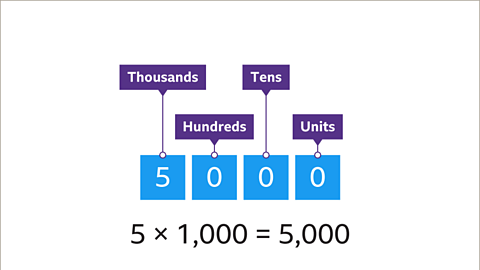
Image caption, There aren’t any hundreds, tens or units, so insert a 0 as a placeholder in each place. 5 x 1000 = 5000
1 of 9
Question
What is 14 x 1,000?
When multiplying by 1,000, each digit moves three places to the left.Insert a 0 as a placeholder in the hundreds, tens, and units place.
14 x 1,000 = 14,000
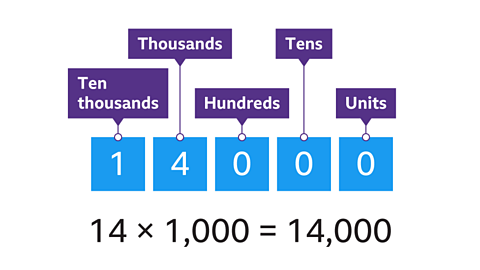
Dividing by 10, 100 and 1,000
Place value can be helpful when dividing by 10, 100 and 1,000. Dividing by a power of 10 (eg 10, 100, 1,000) can lead to a series of zeros after the decimal point which don’t need to be recorded.
Dividing by 10
- When dividing by 10, each digit moves one place to the right. Eg, Thousands become hundreds, hundreds become tens and tens become units.
Dividing by 100
- When dividing by 100, each digit moves two places to the right. Thousands become tens, hundreds become units, and tens and units become fractions of a unit.
Dividing by 1,000
- When dividing by 1,000, each digit moves three places to the right. Thousands become units. Hundreds, tens, and units become fractions of a unit.
Example: dividing by 10, 100 and 1,000
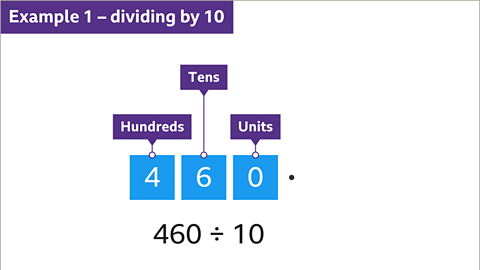
Image caption, Write 460 out with place value labels. To divide 460 by 10, move each digit one place to the right.

Image caption, Each digit has moved one place to the right. This makes 46.0
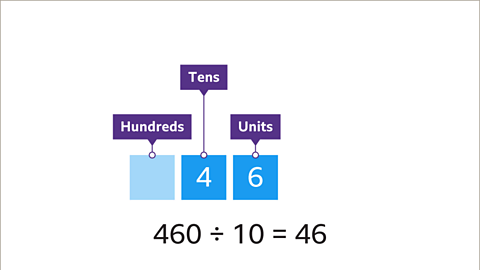
Image caption, 46.0 is the same as 46, so remove the zero and decimal point. 460 ÷ 10 = 46

Image caption, Write 3,700 out with place value labels. To divide 3,700 by 100, move each digit two places to the right.
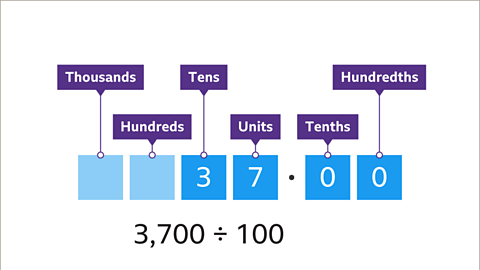
Image caption, Each digit has moved two places to the right. This is 37.00
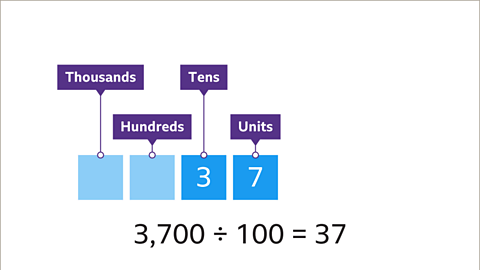
Image caption, 37.00 is the same as 37, so remove the zeros and decimal point. 3,700 ÷ 100 = 37
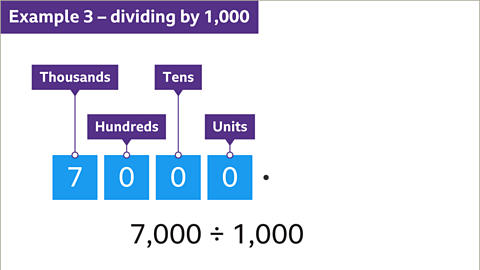
Image caption, Write 7,000 out with place value labels. To divide 7,000 by 1,000, move each digit three places to the right.
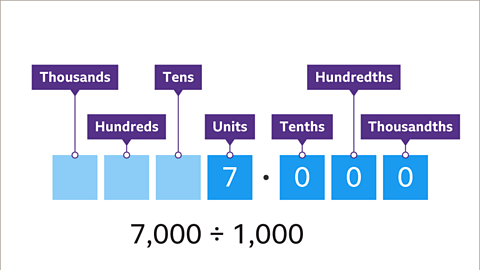
Image caption, Each digit has moved three places to the right. This is 7.000
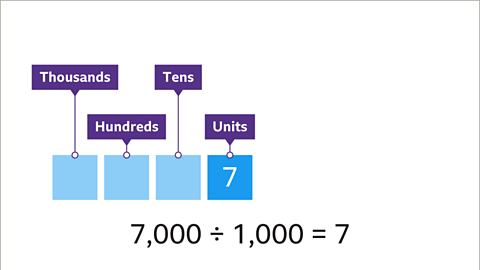
Image caption, 7.000 is the same as 7, so remove the zero and decimal point. 7,000 ÷ 1,000 = 7
1 of 9
Question
What is 47,000 ÷ 100?
When dividing by 100, each of the digits moves two places to the right.
470.00 is the same as 470, so remove the zeros after the decimal point.
47,000 ÷ 100 = 470
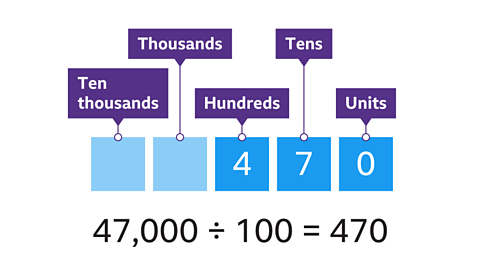
Practise multiplying and dividing by 10, 100 and 1,000
Quiz
Practise what you've learned about multiplying and dividing by 10, 100 and 1,000 with this quiz.
Real-world maths
People may use multiplying or dividing by 10, 100 or 1,000 to work out the cost of different items.

Expensive items are not always paid for in full. Sometimes they are paid for in a number of instalments. For example, a games console costs £450.
A person may want to split their payment over 10 months to make it more affordable. They would need to be able to divide £450 by 10 to calculate the monthly payments.
A shop owner may use this method to calculate profits. For example, they know that they make £2 profit for each box of chocolates they sell. If they sell 100 boxes in a month, they need to multiply by 100. 100 x £2 = £200 profit.

Play the Divided Islands game! gamePlay the Divided Islands game!
Using your maths skills, help to build bridges and bring light back to the islands in this free game from BBC Bitesize.

More on Place value
Find out more by working through a topic
- count4 of 5

- count5 of 5

- count1 of 5
